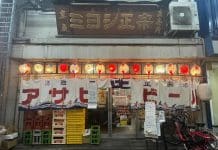
Driving the highways or walking the streets of Japan, you more or less frequently are treated to the sight of a dekotora, a highly personalized truck with large paintings on its sides, featuring an endless array of decorations and running its own wild light show at night.

Those trucks belong to independent contractors expressing their personalities via the design of their trucks. Their drivers tend to be very individualistic characters who clearly like to stay away from regular corporate jobs like driving bland big company design vehicles.
While such attitudes certainly reach back to much earlier times, it was the Toei Studio – produced series Truck Yaro, a 10-part series produced from 1975 to 1979, that really popularized the concept of the dekotora.
Many if not all of the extremely colorful, brightly lit personalized trucks you encounter on the streets today have been inspired by the Toei Truck Yaro movie series of the 1970s.

Truck Yaro, usually translated as Truck Rascal, was an action comedy series focused on a short-tempered trucker named Momojiro Hoshi, nicknamed Ichibanboshi (played by Bunta Sugawara) and his various spontaneous love encounters all over Japan.
Ichibanboshi translates to “Number One Star”, a play on the character’s family name Hoshi which translates to “Star”. Momojiro Hoshi likes to dress in sweaters featuring stars, he always carries a personalized cigarette lighter with a large single star on it, and of course, his nickname is prominently spelled out on his truck.
Bunta Sugawara was at the peak of his career in those days… as a fierce actor putting all his energy into hard-hitting yakuza movies, especially into Kinji Fukasaku’s Battles Without Honor and Humanity series (1973 – 1976).
The Truck Yaro series also presented Sugawara as a tough and rough character, one with a big heart, though. He gets into plenty of fights but generally in a rather humorous manner.
Truck Yaro took its inspiration from the Shochiku studio production Otoko wa Tsurai yo (It’s Tough to Be a Man) aka the Tora-san series. Otoko wa Tsurai yo was directed by Yoji Yamada and starred Kiyoshi Atsumi as Tora-san, a hapless salesman traveling all over Japan. In all the many locations featured over the 48 installments of the series, released between 1969 and 1995, Tora-san has romantic relations with ever changing beauties, only to realize at the end of each installment that she loves someone else.
Truck Yaro adopted the same concept. In every installment of the series, Momojiro Hoshi falls in love with one or two ladies only to finally realize that the girls have other plans for their lives.

All the films have the same theme song, playing over the opening and end credits, Ichibanboshi Blues by Ryudo Uzaki and his wife Yoko Aki, performed by Uzaki’s Down Town Boogie Woogie Band. Uzaki was also known as movie actor in hi00s own right, for example as main actor in Tattoo Ari (1982).
The series follows a clear cut and always repeated pattern of events. There will always be conflicts with other truckers, one in particular. After an epic fistfight in which the interiors of a truck stop restaurant, night club or whatever are totally destroyed, Hoshi and his main competitor will become best friends.

The ladies are always shy and of a rather conservative bend. In the end, they will always make clear to Hoshi that his advances will not be met with success.
Hoshi, a man of great honor, accepts this and will always deliver the lady in question to meet that seemingly impossible deadline set for her… typically a boat or ferry she has to catch.
That final truck ride is always one of the main attractions of the films.
Evading police on the ride, Hoshi will drive his truck high-speed on officially closed backroads, typically through swamps and dense forests. He always makes the deadline – arriving at the port in an impressively muddied-up truck, tree branches sticking out from it and with severely bashed-in glass decorations.
Table of Contents
Run, Truck Rascal, Run! (Japan, 1979) トラック野郎 故郷特急便
Run, Truck Rascal, Run!, the last installment in the series follows exactly that same basic script. Named Torakku Yaro: Furusato Tokkyubin (Truck Yaro: Rapid Hometown Delivery) in the original, this film has a final delivery goal which qualifies it to be included in this review series on Osaka movies.
Hoshi gets a driving job which takes him to Kochi, Shikoku Island. On the ferry to get there, he meets Yuka Onogawa (Sayuri Ishikawa) a very talented but under-recognized singer on her way to her job at a cabaret.

Hoshi falls in love with her instantly. He also falls in love with another woman once he gets to Kochi. In Kochi, he also gets in the hairs with another trucker. After a hilarious battle between the two, destroying the cabaret Yuka works at, the two truckers become friends.
Much truck driving is involved around the Kochi area, each place documentary-style labeled with place name on screen. No doubt, local tourist boards sponsored the movie.
Shikoku is famous for its 88 Temple Pilgrimage. At one point, Hoshi picks up two American hitchhikers traveling the pilgrimage. A couple dressed up in pilgrimage garb; the bearded guy speaks just enough Japanese to create some grand mistakes.
Thus, Hoshi also enters the temple he took them to. There, by total coincidence, he meets Yuka again. For no apparent reason, she sings to Hoshi and the Americans right on the temple steps.
Now, let’s fast-forward, bypassing the convoluted script. Those American hitchhikers were actually the heads of a large Chicago-based record company named “Empire Records”. Impressed by her singing on the temple steps, they want Yuka to come to their big event at the Koma Theater in Umeda, Osaka. Like, the next day.

At the same time, Momojiro Hoshi has finally decided to propose to Yuka. Red roses in hand, he meets her, chats her up. Stricken by Hoshi’s advances, she decides to forget about that train from Kochi to Takamatsu from where her ferry to Osaka would leave. Now, she is in love with Momojiro Hoshi!

In the last minute, one of Yuka’s co-workers shows up and urges her to take her train. Upon hearing about Yuka’s great chance in the music industry, Hoshi throws his red roses in the mud and declares that he will do all he can to help her realize her dreams of being a singer.
The last train from Kochi to Takamatsu is long gone. But Hoshi is sure he can get Yuka to Takamatsu Port in time.

So, he races his truck. Trucker friends help him evade the police. He goes straight through the mountains, through the typical terrain that would leave his truck dirty and damaged beyond belief.

Just in time, they reach the ferry terminal. After a last brief talk with Yuka, Momojiro Hoshi drives off … mission accomplished.

Yuka however has her grand appearance in Osaka. Featured in length, her singing the song Nanguni Tosa wo Ato ni Shite (Leaving the Southern Land of Tosa, Tosa being the old name for the area of Kochi, Shikoku) is an overwhelming success both with the audience as well as (in the back of the stage) the American record producer couple. Yuka will be famous soon.
Actress Sayuri Ishikawa

In real life, singer Sayuri Ishikawa was already very famous when she played young singer Yuka Onogawa in the movie.
Born in 1958 in Kumamoto, Kyushu, Ishikawa made her professional debut as enka singer in 1973. Enka being sentimental ballad songs based on traditional Japanese folk songs but played mostly with modern Western instruments. Enka songs were most popular with the post WWII generation but they still have a large audience today.
In 1977, two years prior to the release of Run, Truck Rascal, Run!, Ishikawa had her biggest success with the song Tsugaru Kaikyo – Fuyugeshiki (Tsugaru Straight – Winter Scene).
Today, Sayuri Ishikawa is considered one of the most successful enka singers in history. By now, she has released more than 100 enka albums, plus a few jazz and rock records.
Since 1977, she has appeared on the NHK Kohaku Uta Gassen New Year’s Night music special, the perhaps grandest regular music TV event in Japan, more than 40 times. That makes her the female artist with the most appearances at the show.
In Run, Truck, Rascal, Run!, she proves that she is also an excellent actress.
In Run, Truck, Rascal, Run!, she proves that she is also an excellent actress.
Actor Bunta Sugawara

Bunta Sugawara (1933 – 2014), the actor playing Momojiro Hoshi in all the Truck Yaro films, became famous as fierce tough guy actor in yakuza films. Playing the lead role in all the films in Kinji Fukasaku’s Battles Without Honor and Humanity series (1973 – 1976), was his breakthrough.
Having grown up in poverty in post-war Tokyo, leading quite a rough life himself at the time, very well prepared him to play the ruthless gangster.
In the Truck Yaro films, however, Sugawara could show that his talents were not limited to gangster roles.
Sure, he plays a rough guy in the Truck Yaro films as well – but a rough guy with a heart of gold who would do everything to help his friends and lovers. At the same time, he showed a great talent for comedy.
The Internet Movie Database (IMDb) lists 242 films in his acting career, stretching from 1956 to 2012.
Younger viewers may be most familiar with Sugawara being the voice actor bringing the Kamaji character to life in Hayao Miyazaki’s Academy Award winning anime Spirited Away (2001). Kamaji was the bathhouse boiler spirit with the incredibly long arms in the phantastic spirit world the film featured, greatly supporting heroine Chihiro.
Spirited Away opened up both a totally new career for Sugawara in anime as well as creating a new fan base among young viewers who hardly knew of his movies from the 1970s.
The Director: Norifumi Suzuki
All 10 Truck Yaro movies were directed by Norifumi Suzuki (1933 – 2014). Suzuki worked for Toei almost his whole career. He started out as assistant director at Toei, then rose up the ranks. His directorial debut was an Osaka movie: Osaka Bad Temper Story: Manservant (1965).
Suzuki shot a number of pink movies early in his career, then went into Toei Pinky Violence, films that featured plenty of female nudity but focused on the violent parts of the story.
Those Pinky Violence films included Girl Boss Guerilla (1972), starring a young Miki Sugimoto. Sugimoto was also the lead actress in the 1976 Osaka movie Violent Panic: The Big Crash, directed by Kinji Fukasaku.
According to the Internet Movie Database (IMDb), Suzuki directed a total of 57 films during his career. Today, his Truck Yaro films are the most widely remembered.
Osaka Locations
The Truck Yaro films generally play out in rather rural areas, usually with a truck stop restaurant as the central location where all the characters meet. Run, Truck, Rascal, Run! follows this tradition, with the cabaret in which Yuka sings being another central location.
It is at that cabaret that Yuka receives the phone call from the management offices of the Koma Theater in Umeda, Osaka. With that call, Osaka becomes the focus of the film, the city of hope, the place of the great chance.

The first image of Osaka to show up in the film comes up only after Momojiro’s truck race to the Osaka ferry in Takamatsu. It depicts a superimposition of a dazzling image of Soemon-cho, the buzzling entertainment district close to Dotonbori in southern Osaka over Yuka’s face. That’s the Osaka she’s heading to.

That image is followed by exterior shots of the Koma Theater (which called itself at the time Umeda Koma Stadium). Umeda of course being in the north of Osaka but only a short subway ride away from Soemon-cho and Dotonbori.

Yuka’s song performance at the Koma Theater is captured on film in full length. It’s made clear that Yuka will head for the big times from there. Just as actress / singer Sayuri Ishikawa did.
The final images show Momojiro Hoshi riding his decorated truck through scenic landscapes, culminating in a giant truck convoy with him driving in front…





















